It soon becomes apparent that she sees the world differently from you and I—a superpower she’s harnessed her entire life.
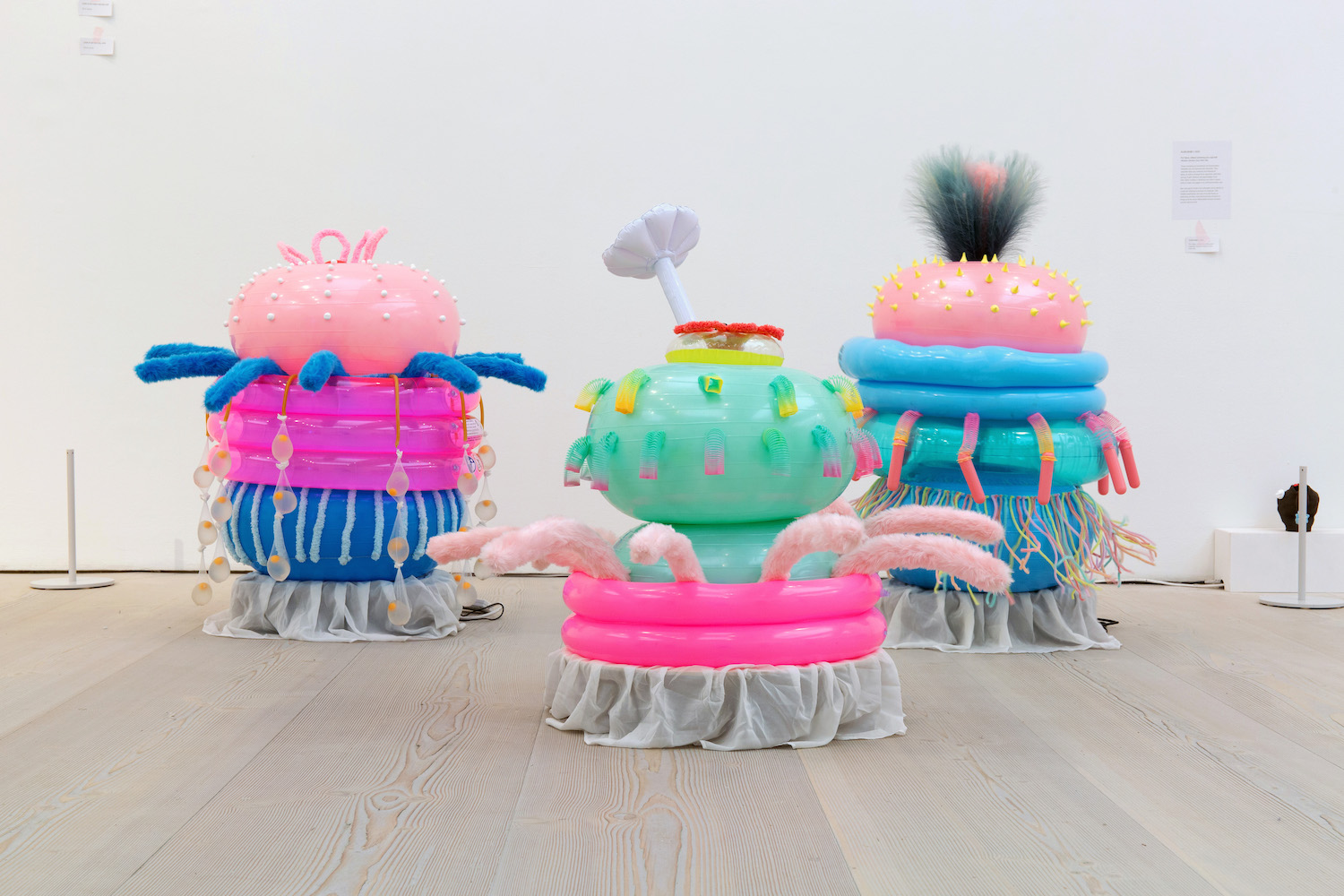
Rong Bao, Alien Babes No. 1,2,3, 2023
Alien Babe Number 1, 2023, PVC fabric, vibration machine, toys, foam clay, 100 x 110 x 110 cm
Alien Babe Number 2, 2023, PVC fabric, vibration machine, toys, foam clay, 103 x 95 x 95 cm
Alien Babe Number 3, 2023, PVC fabric, vibration machine, toys, foam clay, 120 x 80 x 80 cm
As we begin our conversation, a mischievous joy emanates from sculptor Rong Bao, instantly awakening me from a lethargic Friday. It soon becomes apparent that she sees the world differently from you and I—a superpower she’s harnessed her entire life. Even as a child, she never subscribed to systems, questioning everything from her rigid schooling in China to societal mores. While a headache to her tutors, Bao’s honesty allowed her to resist the norms around her. “I owe this attitude to my parents,” she says. “In China, there is a traditional value system of success, but my parents never cared for it. They always told me to do the thing that makes me happy.” And she’s done exactly that, unleashing her innermost drive to create and question onto the world. With the Gilbert Bayes Award from the Royal Society of Sculptors and the COLAB/Royal College of Art/Yorkshire Sculpture Park Graduate Award already under her belt, her sceptical creativity is here to make a mark.
Bao’s path began in her home city of Beijing where she pursued art from a young age, going on to study at the China Academy of Art in Hangzhou, where she spent three years studying public sculpture. “But the thing is,” Bao admits, “the public sculpture in China is a bit… commercial. It doesn’t embrace contemporary practices; it’s not about discovering yourself.” So, with only one year left to complete her degree, she followed her intuition and started again from the beginning at the Art Institute of Chicago. There, nothing was off limits, and Bao began the search for her new magnum opus. From glass-blowing to fashion to animation, there was no discipline Bao left untouched. But the more she ventured, the more her heart desired a single familiar medium: sculpture.
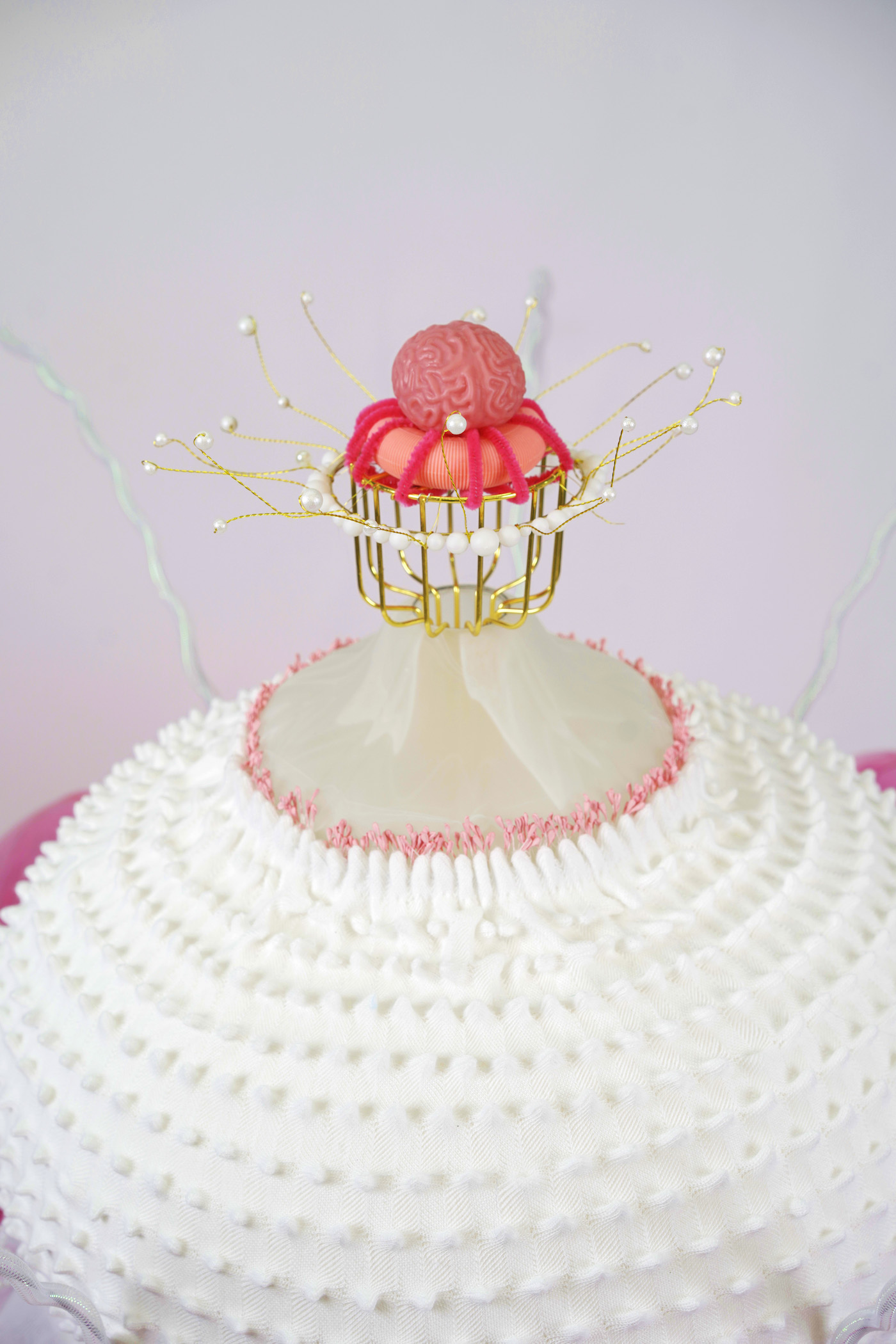
Rong Bao, Pink Roundabout, 2024, PVC fabric, wire, mesh tube, toys, yoga ball, glass, rotate plate, 170 x 170 x 150 cm
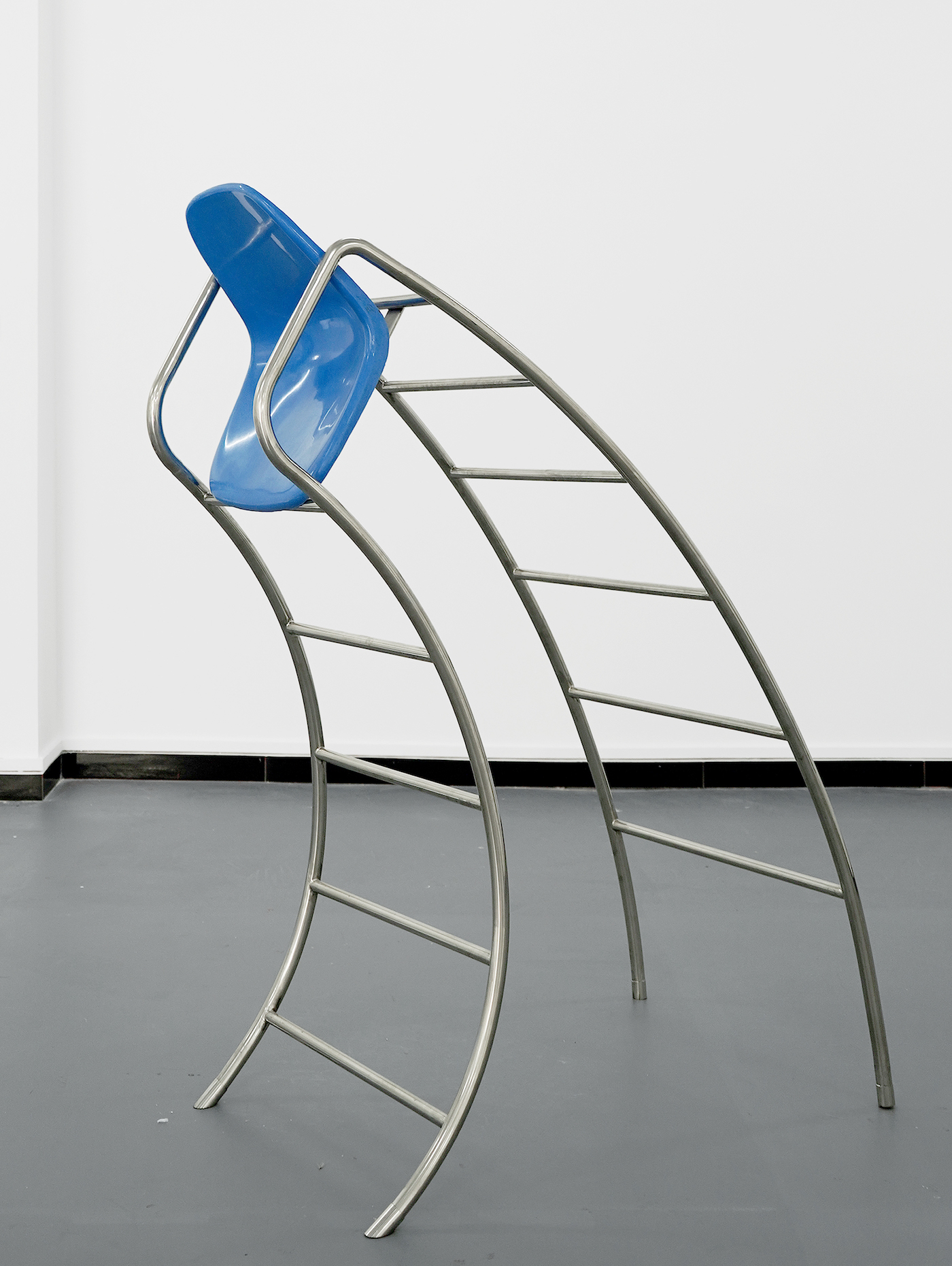
Rong Bao, Stoop, 2023, referee chair, 182x71x200cm
In pursuit of her visual language, Bao continued to expand her sculptural universe during a master’s program at the Royal College of Art in London. Her first year in London marked three years of being unable to go home due to the COVID-19 pandemic. But this restricted mobility birthed a gem: Rong Bao’s walk home. Here, with the help of her code-savvy friends, she developed a program that downloaded every street view image from London to Beijing. She then, for the first time in her practise, used AI to help enhance the quality of the images so she could compile them into a video so all of us can join her digital walk home. The brilliance here lies in the reinterpretation of ordinary technology into a medium of playful expression. In fact, to understand Bao’s work is to begin grappling with this very concept.
Across her oeuvre, Bao defamiliarises the routines of everyday life to make it reappear once again. In doing so, she maintains a solid devotion to environmental neglect and overconsumption in her playfully absurd tone. “I think playfulness is my way of challenging previous forms of contemporary art,” she says, reflecting on Duchamp opening up the contemporary art world with absurdity. But the playful approach to the illnesses that plagued our world comes from something deeper within than just an artistic call: “To be honest,” she says with a cheeky smile beaming across her face, “I think the meaning of being human is to experience different feelings, but I would love to experience more joy if that’s possible.”
This explicitly emerges in ‘Collection 2: Dysfunctional’, where play is infused in objects to make the intangible physical. For example, in ‘The Air in Rong’s Bedroom’, there are bags filled with air captured and packaged from her room, playfully addressing the over-commodification of the world around us. Or ‘Good Luck’, which—like many of her works—invites active viewer participation to bring the piece to life. Here, she recreates the Chinese superstition of stepping over a doorway’s threshold to avoid bad luck. In the sculpture, participants must walk around a panopticon centre that emits a line representing the door threshold. If you miss and step on the light, the panopticon ironically wishes you good luck. Here, Bao has gamified the superstition to meditate on the invisible power structures that control behaviour through surveillance.
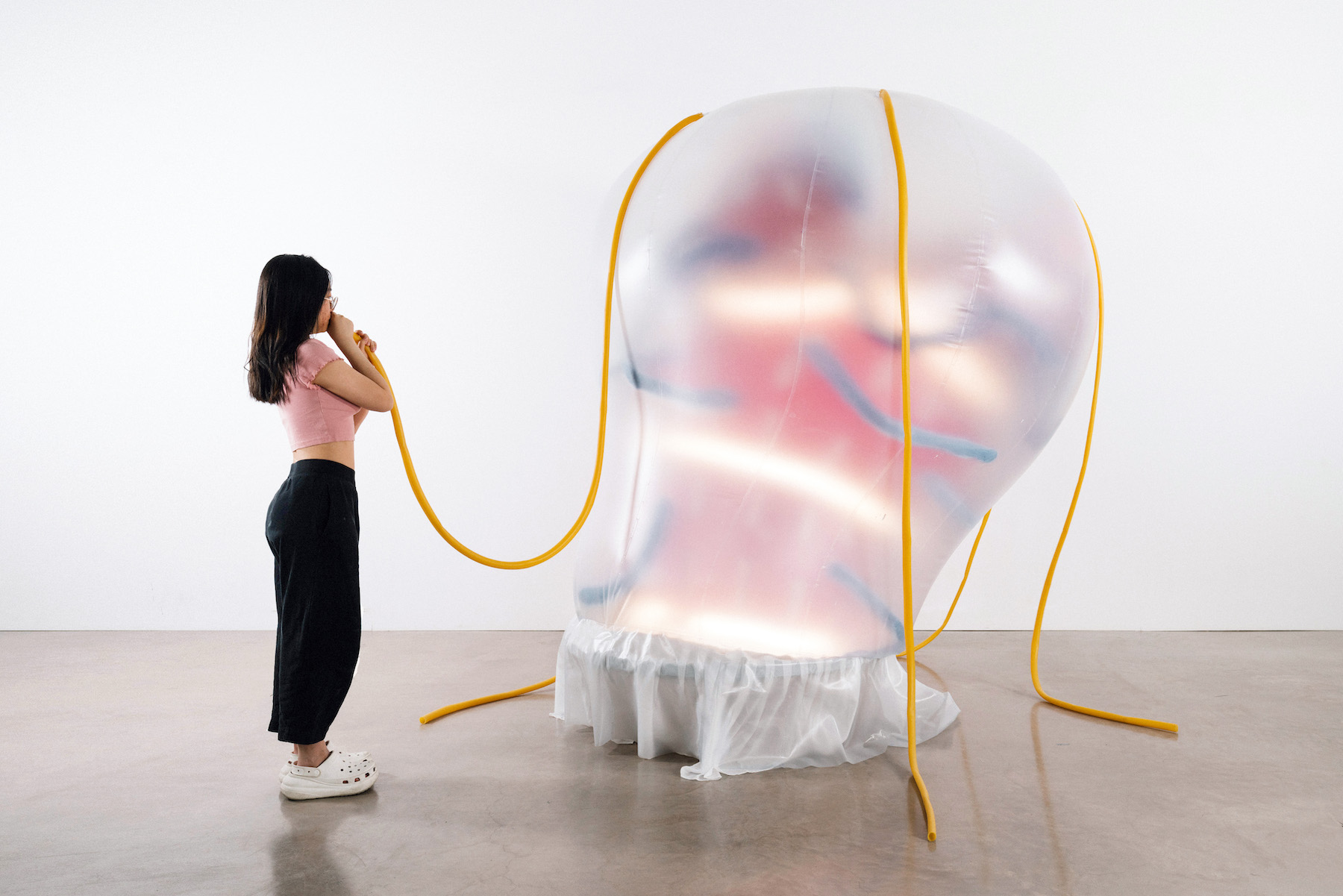
Rong Bao, Alien Rhapsody, 2023, mixed media, 270x250x250cm
Her light-hearted approach truly comes from a place of strength, a place of not letting that which has hurt you conquer who you are: “Look, everybody has trauma, but to conquer that trauma is not to let it control you. To tell your story and treat it as a joke.” To elicit joy in the face of one’s pain, to see playfulness in a hurting world. In fact, this powerfully positive emotional response enables her to effectively meditate on such vital topics. It offers a refreshingly heterodoxic approach that entices viewers to reflect on accepted frameworks.
Bao has recently embarked on her debut solo exhibition, ‘Rong Bao is Me’, at Saatchi Gallery. Her recent pieces in ‘Collection 1: Floating’ have rightfully garnered attention from an international audience. She works with inflatable materials and everyday plastic toys to create plastic creatures. These pieces giggle, breathing and moving as if they were alive. “It’s tough for me to focus on a boring piece. If there is just a sculpture that stands there, I’m one of those people that takes maybe five seconds and then walks away,” she laughs. “So when I’m making art, I’m forced to make something that can always attract my attention or keep my body engaged.” With this awareness, Bao leaps from the ivory tower of the art world, creating work that invites anyone with a curious mindset to participate.
While her fluorescent pink bubbly sculptures are bound to make you smile, there is, of course, a critical message beneath the buoyant surface: “They are constructed of wholly toxic materials, many of which you can find around your house.” Using them as a sculptural medium, Bao crafts a new creature, a new life ‘that doesn’t exist itself but keeps seducing you’. Enticing you with its cuteness as it pollutes the earth, that is.
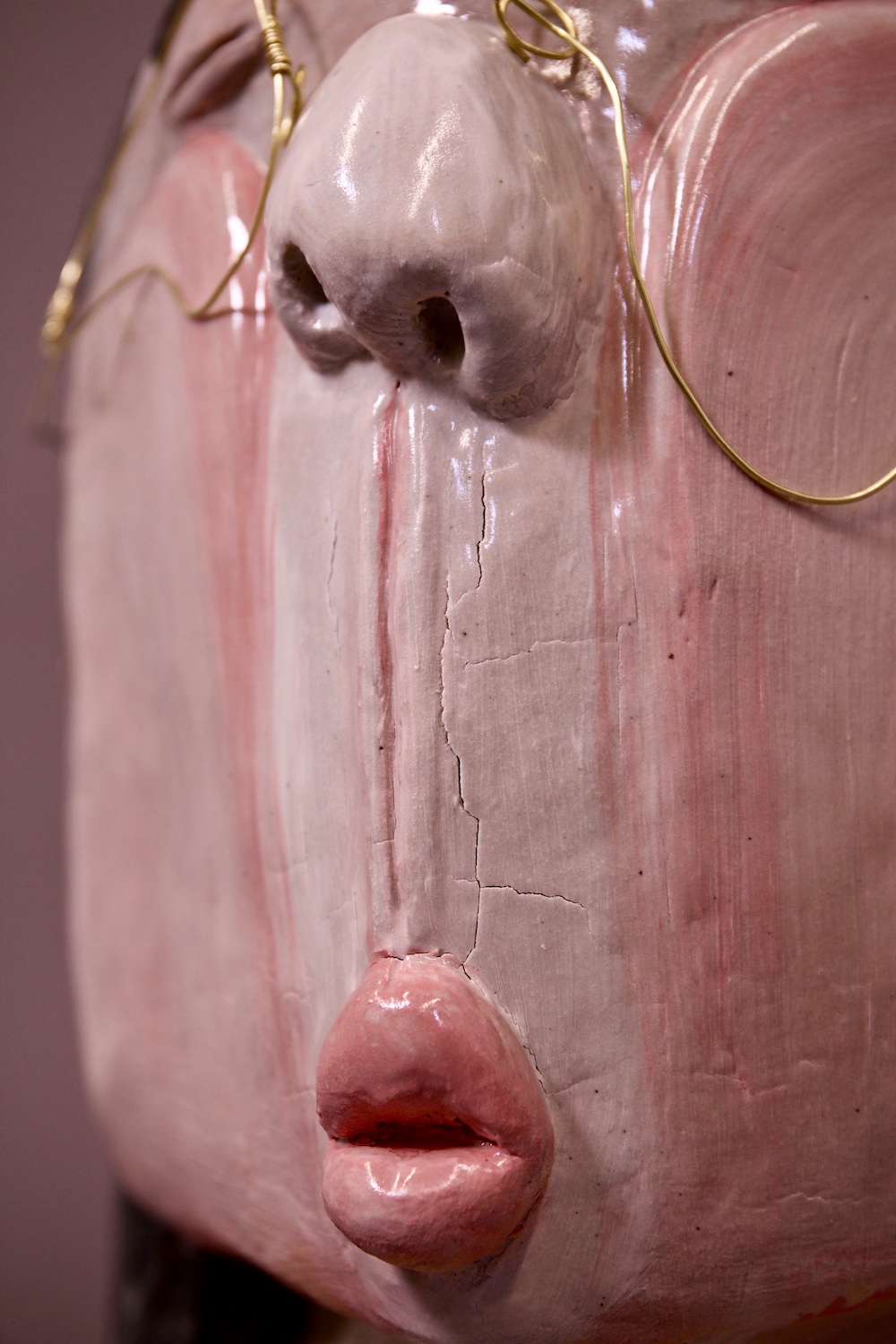
Rong Bao, A Happy Me, 2019, Ceramic, wood, metal, fiber
While exploring this exhibition from the two-dimensional confines of a computer screen, a detail of Bao’s exhibition opening prompted me to wonder. Bao was wearing a shirt with her own face printed on it along with the exhibition name, ‘Rong Bao is Me’. So as we chatted about the exhibition, I had to ask her about it. “Well, to be honest,” she confessed, “when I go to exhibition openings, I sometimes have no idea who the artist is in the crowd. So I printed a shirt with my face and the exhibition title, ‘Rong Bao is Me’, so people would know this is my art.” In fact, while perusing through her work, you’ll find an entire collection, ‘Collection 5: Painting & Sculpture about Me’, dedicated to self-portraiture. That being said, Bao doesn’t believe her work is about herself. Instead, she sees herself positioned in the presence of her own daily life, and thus an additional item in her catalogue of objects to explore.
Stomping into the art scene with the vigour and recognition she deserves, this summer Bao will show at a group exhibition at the LAM Museum in the Netherlands and participate in the Armory Show in NYC this September. Additionally, this coming October, she will unveil a public sculpture above the Temple tube station at the Artist Garden in London. This piece builds on her work titled ‘Enclosed’, where she uses the ground as a sensory labyrinth that guides the blindfolded viewer to offer the perspectives of the visually impaired. Her upcoming public sculpture takes this further, working with visually impaired volunteers to transform the ground into tactile braille to write a poem hidden on the ground. It’s exciting, fun, perspective-bending —and above all, it’s so Rong Bao.
Words by Ella Paritsky
Photography by Yuhao Chen and Kaihao Luo
Courtesy of Eva Herzog Studio
Special thanks to Saatchi Gallery
THE HARD CANDY ISSUE – OUT NOW